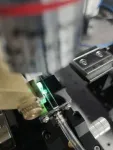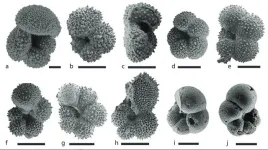(Press-News.org) Researchers have engineered nanosized cubes that spontaneously form a two-dimensional checkerboard pattern when dropped on the surface of water. The work, published in Nature Communications, presents a simple approach to create complex nanostructures through a technique called self-assembly.
“It’s a cool way to get materials to build themselves,” said study co-senior author Andrea Tao, a professor in the Aiiso Yufeng Li Family Department of Chemical and Nano Engineering at the University of California San Diego. “You don’t have to go into a nanofabrication lab and do all these complex and precise manipulations.”
Each nanocube is composed of a silver crystal with a mixture of hydrophobic (oily) and hydrophilic (water-loving) molecules attached to the surface. When a suspension of these nanocubes is introduced to a water surface, they arrange themselves such that they touch at their corner edges. This arrangement creates an alternating pattern of solid cubes and empty spaces, resulting in a checkerboard pattern.
The self-assembly process is driven by the surface chemistry of the nanocubes. A high density of hydrophobic molecules on the surface brings the cubes together to minimize their interaction with water. Meanwhile, the long chains of hydrophilic molecules cause enough repulsion to create voids between the cubes, creating the checkerboard pattern.
To fabricate the structure, researchers applied drops of the nanocube suspension onto a petri dish containing water. The resulting checkerboard can be easily transferred to a substrate by dipping the substrate into the water and slowly withdrawing it, allowing the nanostructure to coat it.
This study stems from a collaborative effort between multiple research groups that are part of the UC San Diego Materials Research Science and Engineering Center (MRSEC). The work featured a synergistic combination of computational and experimental techniques. “We’ve built a continuous feedback loop between our computations and experiments,” said Tao. “We used computer simulations to help us design the materials at the nanoscale and predict how they will behave. We also used our experimental results in the lab to validate the simulations, fine tune them and build a better model.”
In designing the material, researchers chose silver crystal nanocubes due to the Tao lab’s expertise in their synthesis. Determining the optimal surface chemistry required extensive computational experimentation, which was led by Gaurav Arya, a professor in the Department of Mechanical Engineering and Materials Science at Duke University and co-senior author of the study. The simulations identified the best molecules to attach to the nanocubes and predicted how the cubes would interact and assemble on the water surface. The simulations were iteratively refined using experimental data obtained by Tao’s lab. Electron microscopy performed by the lab of study co-author Alex Frañó, a professor in the Department of Physics at UC San Diego, confirmed the formation of the desired checkerboard structures.
Tao envisions applications for the nanocube checkerboard in optical sensing. “Such a nanostructure can manipulate light in interesting ways,” she explained. “The spaces between the cubes, particularly near the corner edges where the cubes connect, can act as tiny hotspots that focus or trap light. That could be useful for making new types of optical elements like nanoscale filters or waveguides.”
The researchers plan to explore the optical properties of the checkerboard in future studies.
Paper: “Self-assembly of nanocrystal checkerboard patterns via non-specific interactions.” Co-authors include Yufei Wang*, Rourav Basak, Yu Xie, Dong Le, Alexander D. Fuqua, Wade Shipley and Zachary Yam, UC San Diego; and Yilong Zhou* and Quanpeng Yang, Duke University.
*These authors contributed equally.
This work was supported by the National Science Foundation, UC San Diego Materials Research Science and Engineering Center (DMR-2011924). The work was performed in part at the San Diego Nanotechnology Infrastructure (SDNI) at UC San Diego, a member of the National Nanotechnology Coordinated Infrastructure, which is supported by the National Science Foundation (grant ECCS-2025752).
END
Nanosized blocks spontaneously assemble in water to create tiny floating checkerboards
2024-06-13
ELSE PRESS RELEASES FROM THIS DATE:
University of Colorado co-leads multicenter randomized trial identifying method of emergency intubation preoxygenation to decrease risk of hypoxemia and cardiac arrest
2024-06-13
In current clinical care, most critically ill adults undergoing emergency tracheal intubation receive preoxygenation through an oxygen mask. Administering supplemental oxygen to patients prior to the start of an intubation procedure increases the oxygen content in the patient’s lungs and decreases the risk of hypoxemia, low levels of oxygen in the blood. However, hypoxemia occurs during 10% to 20% of tracheal intubations in the emergency department or intensive care unit and may lead to cardiac arrest and death.
The University of Colorado co-led a trial with Vanderbilt University that compared the two most ...
Quantum data assimilation: A quantum leap in weather prediction
2024-06-13
Data assimilation is a mathematical discipline that integrates observed data and numerical models to improve the interpretation and prediction of dynamical systems. It is a crucial component of earth sciences, particularly in numerical weather prediction (NWP). Data assimilation techniques have been widely investigated in NWP in the last two decades to refine the initial conditions of weather models by combining model forecasts and observational data. Most NWP centers around the world employ variational and ensemble-variational data assimilation methods, which iteratively reduce cost functions via gradient-based optimization. However, these methods require significant computational resources.
Recently, ...
Ancient ocean slowdown warns of future climate chaos
2024-06-13
When it comes to the ocean’s response to global warming, we’re not in entirely uncharted waters. A UC Riverside study shows that episodes of extreme heat in Earth’s past caused the exchange of waters from the surface to the deep ocean to decline.
This system has been described as the "global conveyer belt," because it redistributes heat around the globe through the movement of the ocean waters, making large portions of the planet habitable.
Using tiny, fossilized shells recovered from ancient deep-sea sediments, the study in the Proceedings of the National Academy of Sciences demonstrates how the conveyor belt responded around 50 ...
Pre-operative use of GLP-1s may reduce complications after metabolic and bariatric surgery in patients with extreme obesity
2024-06-13
SAN DIEGO – June 13, 2024 – A combination of GLP-1 agonists taken before metabolic and bariatric surgery may help patients with extreme obesity lower the risk of post-operative complications, according to a new study* presented today at the American Society for Metabolic and Bariatric Surgery (ASMBS) 2024 Annual Scientific Meeting
Patients with extreme obesity, a body mass index (BMI) of 70 or more, face a higher risk of complications from surgery compared to patients with lower BMIs. Studies have shown weight loss before surgery can mitigate risk but lifestyle intervention ...
Why many lung cancer patients who have never smoked have worse outcomes
2024-06-13
The reason why targeted treatment for non-small cell lung cancer fails to work for some patients, particularly those who have never smoked, has been discovered by researchers from UCL, the Francis Crick Institute and AstraZeneca.
The study, published in Nature Communications, shows that lung cancer cells with two particular genetic mutations are more likely to double their genome, which helps them to withstand treatment and develop resistance to it.
In the UK, lung cancer is the third most common type of cancer and the leading cause of cancer death. Around 85% of patients with lung cancer have non-small cell lung cancer (NSCLC), and this is the most common type found in patients ...
APA poll finds younger workers feel stressed, lonely and undervalued
2024-06-13
Younger workers are struggling with feelings of loneliness and a lack of appreciation at work and tend to feel more comfortable working with people their own age, according to a survey by the American Psychological Association.
The 2024 Work in America survey, conducted online by The Harris Poll of more than 2,000 working U.S. adults, found that three in 10 U.S. workers reported that people in their organization who are not close to their age do not see the value in their ideas (32%). That number was significantly higher for workers aged ...
Shedding light on the state of genetic counseling for hereditary transthyretin-related amyloidosis
2024-06-13
Early detection and treatment of hereditary transthyretin-related amyloidosis via genetic counseling are crucial. Yet, not all at-risk individuals seek genetic counseling, and management for presymptomatic carriers remains unclear. To tackle these knowledge gaps, a research team from Japan conducted a retrospective study on over 200 people who sought genetic counseling at a medical center, shedding light on the current advantages and limitations of current practices.
Hereditary transthyretin-related amyloidosis (AATRv amyloidosis) is a rare inherited ...
Trametinib shows promise for children with relapsed or refractory JMML
2024-06-13
Bottom Line: The MEK inhibitor trametinib (Mekinist) was an effective treatment for pediatric patients with relapsed or refractory juvenile myelomonocytic leukemia (JMML) enrolled in a phase II clinical trial, with seven of 10 patients alive after a median of two years.
Journal in Which the Study was Published: Cancer Discovery, a journal of the American Association for Cancer Research (AACR)
Authors: The senior author is Mignon Loh, MD, who is the director of the Ben Towne Center for Childhood Cancer Research and the head of the Division of Pediatric Hematology, Oncology, Bone ...
New way to spot beetle-killed spruce can help forest, wildfire managers
2024-06-13
A new machine-learning system developed at the University of Alaska Fairbanks can automatically produce detailed maps from satellite data to show locations of likely beetle-killed spruce trees in Alaska, even in forests of low and moderate infestation where identification is otherwise difficult.
The automated process can help forestry and wildfire managers in their decisions. That’s critical as the beetle infestation spreads.
The Alaska Division of Forestry and Fire Protection calls the spruce beetle “the most damaging ...
New study reveals combined use of Donepezil and Memantine increases the probability of five-year survival of Alzheimer’s disease patients
2024-06-13
Alzheimer's disease is the world’s most common neurodegenerative disease, affecting more than 50 million people globally. Alzheimer’s disease is also among the most fatal, landing as one of the top five causes of death worldwide. However, most currently available treatments are limited to alleviating the disease’s symptoms.
Now, a new study led by Chapman University researchers has explored the efficacy of using two existing Alzheimer’s disease drugs simultaneously to reduce mortality. It is one of the largest and ...





